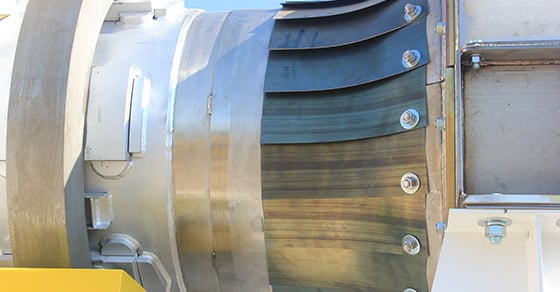Rotary drum seals provide a seal between the rotating drum and stationary housing. This contributes significantly to process efficiency by preventing air from leaking into the drum’s processing environment.
What seals are available?
FEECO offers a number of seal options depending on the level of allowable leakage. The following seals are available:
- Labyrinth Seal (relative leakage >> 5.0%)
- Single Leaf Seal (relative leakage << 3.0% to 5.0%)
- Double Leaf Seal (relative leakage << 1.0% to 3.0%)
- Bellows Seal (relative leakage << 1.0%)
How often do seals require replacement?
The frequency of seal replacement is different in each setting and depends on the specific demands on the drum and its unique processing environment. Visual wear, material back spill, and abnormal auditory cues are signs that seal replacement may be necessary. Unexplained process efficiencies may also indicate a problem with the seal.
A seal that requires frequent replacement could indicate an underlying issue. In this case a qualified technician should conduct a rotary drum audit to determine the cause.
What is the lead time for seals?
While circumstances may vary, seals typically have a lead time between 1-4 weeks for new leaf seal plates or 4-10 weeks for a newly designed seal system.
Is there anything else I need to keep in mind when ordering a seal?
Seal replacement is a good time to evaluate the performance of the seal and whether or not a different seal would better serve the process.
How can I order a seal?
Contact a FEECO Customer Service Engineer for a seal quote by filling out our contact form.
Please be sure to include the following information in the comments:
- FEECO serial number
- Any changes in specs
Or, if FEECO did not provide the original:
- Drum type (cooler, dryer, etc.)
- Mode of heating (direct or indirect, co-current or counter-current)
- Shell temperature at seal area
- Maximum material temperature
- Drum speed
- Outside drum diameter
- Axial expansion of shell at seal location
- Shell material
- Seal required (discharge or feed end)
- Breeching type
- Preferred material of construction
- Breeching type (plugin or enshrouding)
- Dimensions of breeching opening
- Exposed length available for sealing surface
- Suction or pressure
- Corrosive, hazardous gases or vapors


